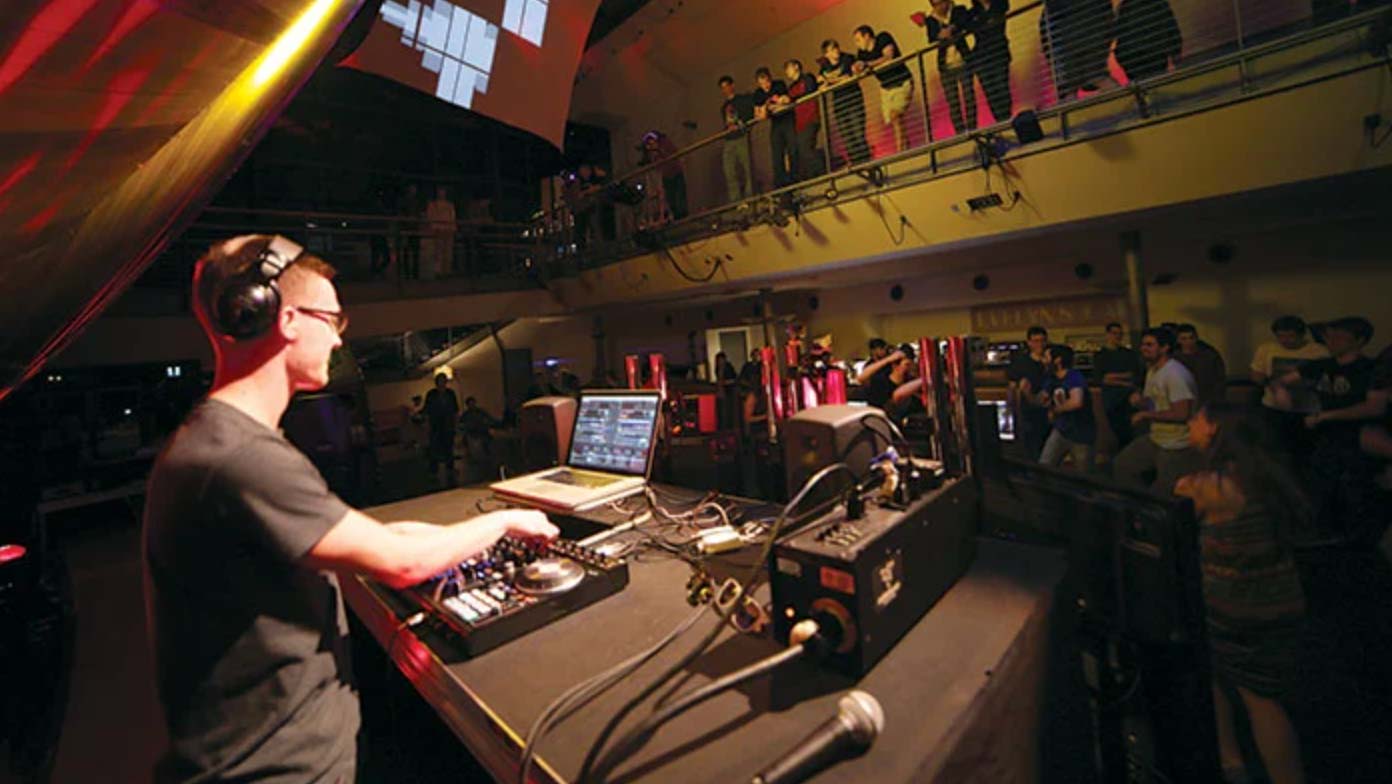“Apprenticeship” Model Gives Student Workers Chance To Learn on the Job
When Caitlin McCleery enrolled at Rensselaer, she never expected she’d end up learning so much about smoke machines and LED lights. Since February, the junior biomedical engineering student has been working with the stage technologies team at the Curtis R. Priem Experimental Media and Performing Arts Center (EMPAC) and, as anyone who has been attending EMPAC shows this fall knows, stage fog and colored strobe lights have been a ubiquitous part of the fall season.
McCleery knew the basics of stage lighting from her experience in high school theater, and has spent much of her college years working with UPAC Lights, the Student Union-run lighting club. Last winter, a graduating senior in UPAC suggested that she apply for a student job at EMPAC. After a couple of emails with the EMPAC master electrician, Dan Swalec, she found herself hanging lights for Extra Shapes, an EMPAC-commissioned dance performance by choreographer DD Dorvillier, which premiered in March.
“I thought it was cool you didn’t need to know what you were doing at first,” McCleery said. “They really let you learn on the job.”
McCleery is one of about 10 students who work behind the scenes on all EMPAC productions, aiding the lighting, video, audio, and stage teams with all aspects of the projects’ development and performance. “I like the ones I get to work on the whole way through,” she said, listing the season-opening MashUP! student dance party and the ongoing Charles Atlas 3D movie shoot as personal favorites. “It’s great practice working with people and troubleshooting problems as they come up. The more time I spend with the team, the more I learn. And then I get to help teach new students who join.”
This “apprenticeship” model for student work extends across all of EMPAC’s departments, from the production teams and the box office and ushering staff, to the curatorial team, administrative office, and public relations team. In total, close to 70 students currently work at EMPAC, making it one of the largest student employers on campus.
“You don’t realize how involved students are at EMPAC,” said Beth Lotterer, a senior materials science and engineering student who has been working at the EMPAC box office since her sophomore year. “There are a huge variety of opportunities.”
Lotterer had little to no experience with EMPAC before she applied for a job as an usher. But she advanced quickly to become an event captain and this year made the transition to the box office, where students are regularly EMPAC’s public face. “I like being here because you get to talk to lots of different people,” she said. “On the rest of campus, we’re very math-focused; here it’s a different aspect we don’t really get in class.”
Asked if her work experience complements her coursework and career aspirations, Lotterer said, “Being able to interact with customers is something that has benefited me. It’s great for business and something you can only learn through experience.”
Recent graduate Gordon Clement ’14 might best represent the trajectory of an EMPAC apprentice. For his Navigating Rensselaer & Beyond (NRB) student orientation event, Clement attended the very first MashUP! in 2010, working with the EMPAC video team during the audiovisual workshop sessions that preceded and planned the show.
A visual arts class he took his freshman year drew him back to many of EMPAC’s events, got him involved in the People Using Live Software and Electronics (PULSE) club, and led him to enroll in IT for Arts and Performance, taught then by EMPAC research engineer Eric Ameres ’88, in 2011. An invitation from Ameres led to Clement joining the EMPAC team as a student research engineer in the summer of 2012. Working on projects such as Thom Kubli’s Black Hole Horizon, which used the geometrodynamic physics of black holes to create giant soap bubbles with enormous audio horns, Clement found himself writing code, refining control systems, 3-D printing, and also “coiling a lot of cables.”
One of his biggest projects had to do with improving the production and test scenario for EMPAC’s 50-foot diameter 360-degree panoramic projection screen. Clement and Ameres decided to build a smaller scale model to do so and in the process realized they had invented “a whole different thing.” The project evolved into “the Campfire,” a visualization tool that supports group interaction and communication. It synchronizes a number of projectors to display data, videos, or maps in three-dimensional space, with the users sitting around it like a real campfire. A patent for this innovative tool is currently being pursued by Rensselaer. (See related story, page 7.)
After graduating last December with a degree in information technology and web science (with a concentration in arts and performance), Clement has been hired as the “media systems integrator to support the newly created Cognitive Immersive Systems Laboratory (CISL) at EMPAC (see related story, page 1). What began as a bit of curiosity in the EMPAC program has become a full-time job in his field of study. And Clement says the process is far easier than most Rensselaer students think.
“If you come to a few events, have an open mind, and look at the technology, you’ll get past the hang up—‘why are they doing this?’—and get to ‘wow, this is crazy and awesome,’ ” he said.

The “apprenticeship” model for student work extends across all of EMPAC’s departments. In total,
close to 70 students currently work at EMPAC, making it one of the largest student employers on campus.